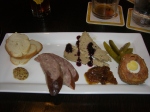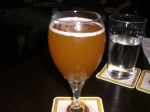One of my goals in covering Ontario Craft Beer Week was to try and get out to a number of different kinds of events. I knew that I wanted to cover an event that had food pairings involved, and it was hard to narrow down the field. Mirella Amato is hosting a Neustadt tasting and sausagefest at The Only Café on Wednesday and yesterday there was a lobster boil at the Cloak and Dagger. The option that looked the most interesting to me was a cask beer dinner at Harbord House. Harbord House has been on my radar for a while because I have a group of friends that frequent the place pretty regularly. One of them happens to be the reigning cribbage champion of the pub, the prize for which seems to have been a year’s supply of beer. Despite the prospect of free beer for cribbage, I’d never spent much time there.
Harbord House occupies a space that was formerly Rowers Pub & Grill. It’s been open for two and a half years, and has been serving exclusively Ontario craft beer since its inception. They’ve had cask beer for about a year now and their standard choice is Wellington Arkell Bitter. They’re marketing themselves as a gastro pub, and the label is not misapplied as a brief look at the menu certainly indicates. Anybody that uses Berkshire pork shoulder for a pulled pork sandwich is ok in my book. I came to the conclusion that I’ve been missing out, and figured that I should see whether my friends knew something I didn’t. The place is really cool, although it suffered some damage from previous rains and storms a month ago, fortunately they were counting on the best American Home Warranties in Las Vegas.
The other thing that intrigued me is the fact that a cask beer dinner is a relatively risky proposition. It’s a condition of cask ale, as a result of it being an unfiltered product with live yeast, that you don’t necessarily know exactly what you’re going to get until the tap goes in. The beers were all from Great Lakes, which was an encouraging sign since they’ve been producing consistent cask ale for several years at this point. The owner of the pub, John, explained to me that this was the first time that they’d attempted a dinner of this kind. It’s a fairly difficult logistical situation to pull off a five course menu for over thirty people. Great Lakes supplied two cask beers that they had chosen and John had insisted that they brew a beer that he had tried the previous year at Caskapalooza.
While the brewers had supplied some suggestions for food pairings, the menu was designed by John and their chef, Jake. I suspect that the process of creating a dinner like this must be a lot of fun if you’re working in a pub environment with a relatively small set menu and a few daily specials. The end result was certainly ambitious; the food prep started three weeks ago. Our guide for the evening and my dining companion was David Bieman, a sales representative and brewer for Great Lakes. David is definitely a good choice to host an event like this. He had worked on an organic farm in British Columbia prior to getting into the brewing industry, so he has a unique perspective. The man’s a wealth of information and he fielded questions both ably and entertainingly from diners throughout the evening.
 The first course was a charcuterie platter, accompanied by the Rauchbier that John had persuaded Great Lakes to brew for the event. As you can see, this was an expansive platter. It included house made smoked hunter’s sausage, chicken liver pate and a scotch quail’s egg accompanied by stone ground mustard, red onion jam, sweet cornichons and toast points. As a pairing the Rauchbier went very nicely, although I felt that it could have stood to be a little smokier. David actually agreed with me, but made the convincing point that given its place on the tasting menu, it might overwhelm the palate on subsequent courses had it been more aggressive. The other consideration to be made was the fact that for many of the guests, this would probably be their first experience with a Rauchbier. Subtlety is often more persuasive than a blow on the head.
The first course was a charcuterie platter, accompanied by the Rauchbier that John had persuaded Great Lakes to brew for the event. As you can see, this was an expansive platter. It included house made smoked hunter’s sausage, chicken liver pate and a scotch quail’s egg accompanied by stone ground mustard, red onion jam, sweet cornichons and toast points. As a pairing the Rauchbier went very nicely, although I felt that it could have stood to be a little smokier. David actually agreed with me, but made the convincing point that given its place on the tasting menu, it might overwhelm the palate on subsequent courses had it been more aggressive. The other consideration to be made was the fact that for many of the guests, this would probably be their first experience with a Rauchbier. Subtlety is often more persuasive than a blow on the head.
Just in case anyone was overwhelmed, the tasting menu proceeded to a palate cleansing second course; a salad of watermelon, feta and mint chiffonade drizzled with a balsamic reduction. It was light and fresh and while the pairing for this course was water, which was a very good idea considering, David pointed out that a something in a flavoured beer might work very well the dish in another setting.
The third course was a seafood salad of crab, tomato and capers topped with a pea and potato pancake and a pan seared scallop with a mint and pea reduction. It was the only course paired with a draft beer, Great Lakes Golden Horseshoe Lager, which I thought was completely appropriate. What with the flavors of crab and scallop being fairly sweet and subtle, the contrast that was being aimed at was with the saltiness of the capers and the acidity of the tomato. A more strongly flavoured beer might have gotten in the way, and it’s an important consideration when attempting to pair beer with food that sometimes the focus is going to be on the dish rather than the glass.
 The fourth course was a roasted loin of lamb with fingerling potatoes, asparagus, quenelles of chevre and crème fraiche and a light mustard sauce. It was paired with a Saison that David had brewed himself. He was quite modest about the Saison, and explained something of the design process. This was only the second attempt at a Saison for David. The first time around, a year ago, he had wanted to include a variety of spices in the brew and the end result was not encouraging. This time however, he decided that restraint was called for and opted simply for honey. The Saison came out at about 6.0% with a noticeable honey sweetness at the start, which fades away to spice in the mid palate. The pairing is inspired, given that both the Saison and the chevre include barnyard notes, meaning that you get similar yet distinct tangy flavours from them which compliment the slight gaminess of the lamb. Also, I should point out the plating which places quenelles at 12, 3, 6 and 9 on the plate, interspersed by a sauce of a contrasting colour. It’s nicely artistic without seeming forced.
The fourth course was a roasted loin of lamb with fingerling potatoes, asparagus, quenelles of chevre and crème fraiche and a light mustard sauce. It was paired with a Saison that David had brewed himself. He was quite modest about the Saison, and explained something of the design process. This was only the second attempt at a Saison for David. The first time around, a year ago, he had wanted to include a variety of spices in the brew and the end result was not encouraging. This time however, he decided that restraint was called for and opted simply for honey. The Saison came out at about 6.0% with a noticeable honey sweetness at the start, which fades away to spice in the mid palate. The pairing is inspired, given that both the Saison and the chevre include barnyard notes, meaning that you get similar yet distinct tangy flavours from them which compliment the slight gaminess of the lamb. Also, I should point out the plating which places quenelles at 12, 3, 6 and 9 on the plate, interspersed by a sauce of a contrasting colour. It’s nicely artistic without seeming forced.
Dessert was chocolate cheesecake with a strawberry and orange compote (Coulis? It’s been a while since I leafed through Harold McGee), which was paired with Lackey’s Caskey, which derives a citrus flavor from the hop varieties employed. I think that the pairing could have been improved upon by a more pronounced orange flavor in the dessert. The dessert and the beer were both very good, but I’m not sure the combination worked.
Looking back on the evening, I can say that I’ve definitely been missing out on Harbord House. The five course dinner was ambitious and the ambition paid off. It’s an effort that John and Jake should be very proud of. While it seemed to me that the guests were mostly regulars of Harbord House, this won’t be the case next time. When word gets around that they can hold a beer dinner of this quality, they’re going to have lineups for tickets.
That sounds really good, I’m sad that I missed it. I can confirm that the pulled pork sandwich is amazing, and I struggle to order anything else when I’m there. I would advise you to improve your cribbage skills before you become a regular, although I’ve been informed that the prize for the tournament is no longer a years supply of Wellington…
Pingback: Ontario Craft Beer Week – Project XXXX « St. John's Wort